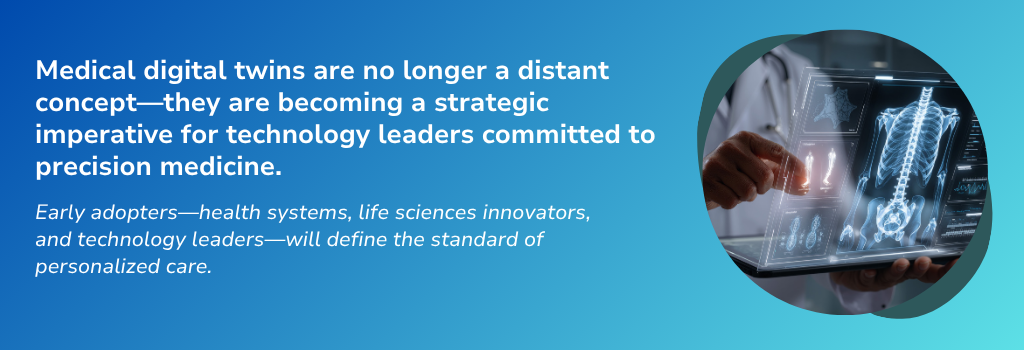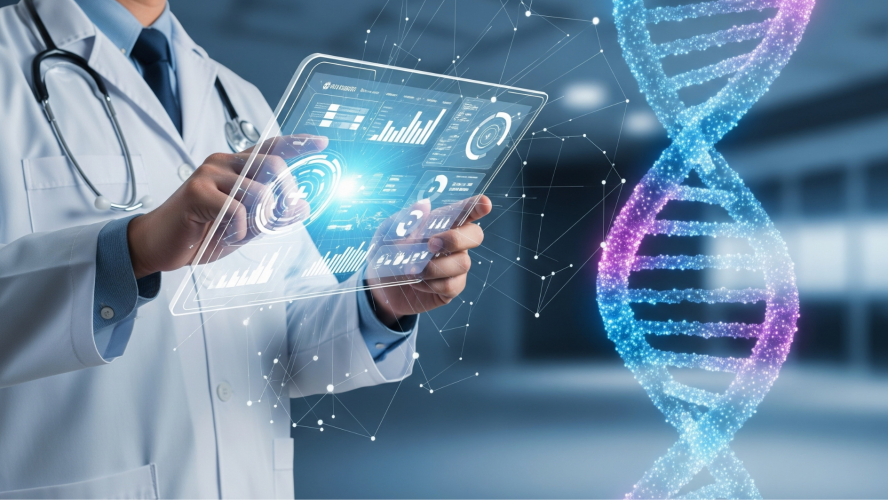Medical Digital Twins — When the Soul Meets the Body in Medicine
For centuries, doctors have treated the human body by looking outward—at symptoms, scans, lab results, and clinical guidelines. But anyone who has faced illness knows that medicine often misses the inner story of the patient—the “soul” of health that evolves over time.
Now, a powerful idea is emerging: the medical digital twin (MDT). Think of it as a living, breathing digital soul that mirrors the body. Unlike static medical records or imaging scans, this twin evolves with you—learning from your data, simulating your health journey, and even predicting the future of your well-being.
This isn’t science fiction. It’s the next chapter of precision medicine, powered by AI, data, and biology coming together.

From Digital Twin to Medical Digital Twin: The Soul’s Five Pillars
Just as the soul is more than the sum of organs, a true medical digital twin is more than a model. It has five essential core components, each assisting to mirror the state of the body:
- The Patient (Body) – The biological system of interest, ranging from the whole patient to specific organs or disease processes, captured through multimodal data (EHRs, lab tests, genomics, imaging, wearables).
- Data Connection – The integration of your vital signals—genomics, imaging, lab tests, wearables— often as unstructured data, into the digital soul in usable format for modeling.
- Patient-in-Silico (Digital Twin) – A virtual you, an inner mirror. This is where biology becomes story: your disease progression, your treatment responses, your “what ifs.” This may include mechanistic models (mathematical equations based on biological knowledge), AI-based models (data-driven predictions), or hybrid approaches.
- Interface (Voice of the Soul) – An interface that allows doctors (and you) to ask questions and hear answers. Think of AI-based interfaces, particularly large language models (LLMs) whispering back in a language we can understand.
- Twin Synchronization (Harmony) – The rhythm of life itself, where every new heartbeat, lab test, or therapy updates your twin. The real-time representation of vital statistics.
Without all five, the twin is lifeless—just as a body without a soul is incomplete.
The Technologies: How We Listen to the Soul
A medical digital twin is only as alive as the technologies that sustain it. Just as the human body depends on organs and senses to keep the soul in harmony, the twin requires a set of enablers to capture, interpret, and simulate health in real time.
Continuous Data Acquisition — The Pulse of the Body
- Genomic and molecular sequencing: Fourth-generation sequencing, liquid biopsies, and epigenetic profiling provide snapshots of cellular identity. These inputs allow the twin’s “soul” to sense disease at the molecular level, detecting mutations, heterogeneity, and progression.
- Wearables and digital devices: Continuous monitoring of vitals, sleep, and activity brings a steady rhythm of life into the twin. Subtle deviations—often invisible to clinical tests—become signals the digital soul can interpret as early warnings.
Artificial Intelligence — The Interpreter of the Soul
- Data harmonization and feature extraction: AI converts fragmented medical inputs—CT scans, free-text clinical notes, lab reports—into structured knowledge. This process is akin to nerves translating stimuli into meaning for the brain.
- Data fusion: By combining genomics, imaging, proteomics, and clinical labs, AI weaves a tapestry richer than any single thread. In this fusion, the body’s scattered signals are transformed into a unified digital consciousness.
- Predictive modeling: Recurrent neural networks and transformers can simulate disease trajectories without full mechanistic knowledge, enabling the soul-in-silico to forecast paths the body may take.
Mechanistic Modelling — The Laws of Nature
Mechanistic models encode biology into mathematics—ordinary and partial differential equations that describe processes such as tumor growth or insulin-glucose regulation.
These models provide not just predictions, but explanations—the kind of grounded understanding that anchors the soul to the rules of physiology.
Fusion of AI and Mechanistic Modelling — Mind and Heart Together
- Data augmentation: Mechanistic models can generate realistic synthetic data to train AI, improving generalization when real-world data are limited.
- Physics-Informed Neural Networks (PINNs): These architectures embed biological laws directly into neural networks, ensuring predictions remain physiologically coherent.
- Personalization across populations: By combining genotype-based mechanistic models (e.g., CYP2D6 activity in tamoxifen metabolism) with AI’s predictive power, the twin becomes capable of tailoring treatments without relying on blunt population averages.
Implementation: Teaching the Soul to Walk
A major challenge is validating MDTs before clinical deployment. This is where retrospective data staging comes in.
- Historical patient data are staged into time segments (e.g., treatment cycles).
- The MDT is updated incrementally to mimic real-time synchronization.
- Predictions are compared against actual outcomes to evaluate accuracy and uncertainty.
This approach allows rigorous testing of MDTs while respecting the principle of dynamic patient-model alignment. Imagine walking through your past step by step—feeding your twin pieces of your medical history in sequence. Each time, the twin makes predictions, learns, and grows closer to your lived truth.
Applications: Where Soul Meets Healing
Oncology: Fighting Cancer with the Inner Mirror
Cancer as a dynamic system
- Tumors evolve, resist, and adapt—making static treatment plans inadequate.
- The patient-in-silico acts as the “soul mirror” of the tumor, continuously learning from new patient data.
Adaptive therapy
- Clinical trials in prostate cancer showed that adjusting abiraterone dosing based on real-time PSA levels—guided by digital twin models—extended survival.
- Instead of eradicating all sensitive cells (which accelerates resistance), therapy was paused and restarted, preserving competition between sensitive and resistant clones.
Mechanistic modeling
- Used Lotka–Volterra equations (competition dynamics) to simulate tumor populations.
- Retrospective data validated predictions, showing strong alignment with actual patient PSA levels.
Future oncology twins
- Will integrate demographics, comorbidities, genetic profiling, imaging, and lifestyle data.
- Capable of predicting side effects, simulating treatment combinations, and personalizing survival estimates.
Diabetes: A Digital Guardian Angel
Chronic vigilance challenge
- Diabetes management requires constant monitoring of glucose, insulin, diet, and lifestyle—often overwhelming for patients and clinicians.
- A digital twin acts as a guardian “soul,” shouldering part of this cognitive load.
AI-based decision support systems (AI-DSS)
- Clinical trials (e.g., ADVICE4U) showed AI-driven insulin dosing recommendations were non-inferior to physician adjustments.
- The patient-in-silico represents glucose dynamics, integrating insulin dose, prior glucose trends, and carbohydrate intake.
Twin synchronization
- Updates occur every few weeks, or even daily in advanced systems, reflecting real-time physiology.
- Feedback delivered via mobile apps ensures accessibility—even in resource-limited settings.
Expanding the model
- Next-gen twins will incorporate nutrition, exercise, and sleep patterns into predictive models.
- Mechanistic + AI fusion could allow better HbA1c prediction, postprandial glucose control, and precision nutrition guidance.
Conclusion: Toward Medicine with a Soul
We live in an age where machines can read genomes, track heartbeats, and simulate cells. But what medicine has long lacked is a way to tie these fragments into a living whole.
The medical digital twin offers that possibility: a soul for healthcare that grows with the body, harmonizes data into meaning, and helps both patients and clinicians make wiser choices.
It is not about replacing the physician’s art, but enriching it. Not about reducing humans to numbers, but elevating numbers into narratives of life.
In the near future, when you walk into a clinic, your doctor might not just see your chart—they’ll see your soul’s digital reflection, evolving with every breath you take. And together, body and soul will guide your path toward healing.


